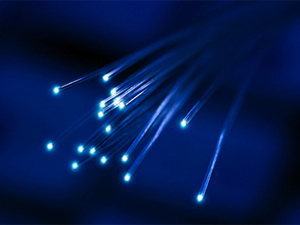



Date:15/08/16
 Scientists have developed a new material that may not only provide efficient lighting, but also power wireless internet with data speed of up to two gigabytes per second.
Scientists have developed a new material that may not only provide efficient lighting, but also power wireless internet with data speed of up to two gigabytes per second.
Researchers from King Abdullah University of Science and Technology (KAUST) in Saudi Arabia developed the new nanocrystalline material that rapidly makes white light out of blue light.
While Wi-Fi and Bluetooth are now well established technologies, there are several advantages gained by shortening the wavelength of the electromagnetic waves used for transmitting information.
Visible-light communication (VLC) makes use of parts of the electromagnetic spectrum that are unregulated and is potentially more energy-efficient, researchers said.
VCL also offers a way to combine information transmission with illumination and display technologies - for example, using ceiling lights to provide internet connections to laptops, they said.
Many such VLC applications require light-emitting diodes (LEDs) that produce white light. These are usually fabricated by combining a diode that emits blue light with phosphorous that turns some of this radiation into red and green light.
However, this conversion process is not fast enough to match the speed at which the LED can be switched on and off.
"VLC using white light generated in this way is limited to about one hundred million bits per second," said Boon Ooi, a professor at KAUST.
Researchers instead used a nanocrystal-based converter that enables much higher data rates.
They created nanocrystals of cesium lead bromide that were roughly eight nanometres in size using a simple and cost-effective solution-based method that incorporated a conventional nitride phosphor.
When illuminated by a blue laser light, the nanocrystals emitted green light while the nitride emitted red light. Together, these combined to create a warm white light.
Researchers characterised the optical properties of their material using femtosecond transient spectroscopy.
They were able to show that the optical processes in cesium lead bromide nanocrystals occur on a time-scale of roughly seven nanoseconds.
This meant they could modulate the optical emission at a frequency of 491 Megahertz, 40 times faster than is possible using phosphorus, and transmit data at a rate of two billion bits per second, researchers said.
The white light generated using their perovskite nanostructures was of a quality comparable to present LED technology, researchers said.
The research was published in the journal ACS Photonics.
New nano-material promises 2GB data speed per second
 Scientists have developed a new material that may not only provide efficient lighting, but also power wireless internet with data speed of up to two gigabytes per second.
Scientists have developed a new material that may not only provide efficient lighting, but also power wireless internet with data speed of up to two gigabytes per second.Researchers from King Abdullah University of Science and Technology (KAUST) in Saudi Arabia developed the new nanocrystalline material that rapidly makes white light out of blue light.
While Wi-Fi and Bluetooth are now well established technologies, there are several advantages gained by shortening the wavelength of the electromagnetic waves used for transmitting information.
Visible-light communication (VLC) makes use of parts of the electromagnetic spectrum that are unregulated and is potentially more energy-efficient, researchers said.
VCL also offers a way to combine information transmission with illumination and display technologies - for example, using ceiling lights to provide internet connections to laptops, they said.
Many such VLC applications require light-emitting diodes (LEDs) that produce white light. These are usually fabricated by combining a diode that emits blue light with phosphorous that turns some of this radiation into red and green light.
However, this conversion process is not fast enough to match the speed at which the LED can be switched on and off.
"VLC using white light generated in this way is limited to about one hundred million bits per second," said Boon Ooi, a professor at KAUST.
Researchers instead used a nanocrystal-based converter that enables much higher data rates.
They created nanocrystals of cesium lead bromide that were roughly eight nanometres in size using a simple and cost-effective solution-based method that incorporated a conventional nitride phosphor.
When illuminated by a blue laser light, the nanocrystals emitted green light while the nitride emitted red light. Together, these combined to create a warm white light.
Researchers characterised the optical properties of their material using femtosecond transient spectroscopy.
They were able to show that the optical processes in cesium lead bromide nanocrystals occur on a time-scale of roughly seven nanoseconds.
This meant they could modulate the optical emission at a frequency of 491 Megahertz, 40 times faster than is possible using phosphorus, and transmit data at a rate of two billion bits per second, researchers said.
The white light generated using their perovskite nanostructures was of a quality comparable to present LED technology, researchers said.
The research was published in the journal ACS Photonics.
Views: 419
©ictnews.az. All rights reserved.Similar news
- Azerbaijani project to monitor disease via mobile phones
- Innovative educational system to be improved under presidential decree
- NTRC prolongs license of two TV and radio organizations for 6 years
- Azerbaijan establishes e-registry for medicines
- Azerbaijani museum introduces e-guide
- Nar Mobile opens “Nar Dunyasi” sales and service center in Siyazan city
- International conference on custom electronic services held in Baku
- OIC secretary general to attend COMSTECH meeting in Baku
- Azerbaijan develops earthquake warning system
- New law to regulate transition to digital broadcasting in Azerbaijan
- Azerbaijani State Social Protection Fund introduces electronic digital signature
- Intellectual traffic management system in Baku to be commissioned in December
- Tax Ministry of Azerbaijan started receiving video-addresses
- World Bank recommends Azerbaijan to speed up e-service introduction in real estate
- Azerbaijan to shift to electronic registration of real estate





















